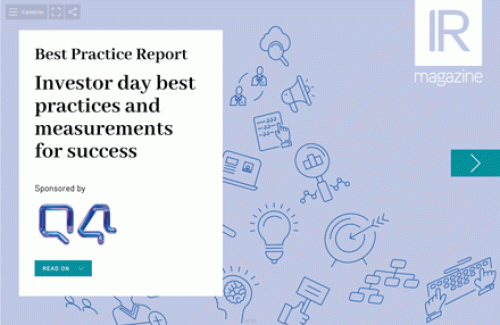At the latest IR Magazine Think Tank – East Coast in New York, industry experts, top-rated IROs and members of the investment community tackled topical issues affecting IR professionals today.
Panel sessions and roundtables delved into a wide range of topics, including: how political elections across the globe will affect businesses, their operations and investors’ behavior; how IR teams can adapt to a changing corporate access environment, facilitate quality in-person investor engagement and optimize their time with management; how to prepare management and analysts in the lead-up to earning calls; and more. Below are some of the key takeaways from the event.
Be resilient during political elections and times of economic uncertainty
As one attendee noted, IROs are not expected to be economic or political experts. But with nearly half the global population already headed or soon to be heading to the polls this year, investors and companies alike need to consider how global events impact their business.
From a buy-side perspective, investors focus on business models that will perform regardless of election cycles or outcomes and wider geopolitical issues. That said, the buy side will be cautious about companies that have significant exposure to such factors and would expect IR teams to be transparent about the potential impact of these events on their specific business.
During these periods IROs are advised to focus on highlighting the company’s strengths, adaptability and long-term vision. ‘[We] can give [investors] examples of [how] we’ve been through an adverse situation and how we came out on the other side much stronger. That shows the strength of the management team and the bench,’ said one panelist. Focusing on controllable factors is crucial to reassure investors.
Ensure you balance transparency with measured communication
It is counterproductive for companies to downplay challenges or provide overly optimistic narratives. For example, a buy-side investor mentioned a portfolio company impacted by the Russian invasion of Ukraine. The firm found it helpful when the company demonstrated a thorough evaluation of the situation and the logic behind its strategic response.
For investors, a framework for navigating uncertainty is more helpful than unrealistic estimates or a total lack of engagement. It’s that honesty that is going to build trust. ‘If you say nothing, the sell side and buy side will generate their own numbers, and your stock will then fluctuate [as a result] – I don’t think saying nothing is good,’ one speaker said.
On the other hand, panelists also noted that overcommunicating with investors, presenting too many possibilities and setting deadlines the business is not sure can be met may be counterproductive. ‘[Do not] let the narrative run away from you with all these different scenarios: be neutral,’ one panelist said.
Don’t sit on your earnings call prep
Considering what to expect in the next earnings season, how to manage consensus and the time it takes to prepare management teams in the lead-up to the earnings call, speakers said the first thing is to start preparing as soon as the last earnings call ends. That will allow IROs, who often lead the function solo, to stay on top of business developments.
‘I am always trying to keep a finger on the pulse of what has continued to evolve throughout the quarter, so that I’m not sitting there three weeks before the earnings [wondering] what we want to talk about in each of these business units,’ a speaker said. ‘Know what the key messages are and what the key drivers are, and then it’s just honing in on how you tie that to the numbers.’
Developing clear and concise key messages you want to communicate from an IR perspective and submitting them to management will also help every question on the day get a proper answer.
‘We just started implementing a couple of quarters ago what we call a message compass, which is the key messages we want to get across on our earnings calls,’ one attendee noted. ‘There’s going to be a million different ways somebody could ask a question. If there’s something that comes up where we’re maybe not as prepared as we wanted to be, or if it comes up differently, you’ve always got this message compass you can go back to.
‘The management team knows it can answer [that] question in a way and then bring it back to the key message – that’s helped us make sure we are clear, consistent and concise.’
Plan your roadshow strategically
With new trends related to hybrid working, business travel and event attendance, it’s challenging for businesses to fill roadshow schedules and enhance management’s time on the road. So what factors should companies consider before heading out?
To start, it is important to craft a rough plan looking at how many events the company did the previous year or a couple of years ago, and on that basis think about what would work for the current year. For some, there is never a bad time for a roadshow as it is always the right time to get in front of investors. For others, it is critical to pay attention to timings and be considerate of the fact that management’s time is valuable so the C-suite cannot be constantly traveling.
Another factor to consider when putting together a roadshow schedule is to allow the business enough time to build up and reach milestones, some panelists agreed. Ensuring the business alternates time on the road with quiet periods and considering quarter by quarter whether there is a strong reason to get in front of investors can help the business ensure it delivers impactful messages to shareholders.
Build a strong partnership with your roadshow partners
Open communication and collaboration are essential between the company and the wider partners involved in roadshow planning. Ultimately, what matters is to ensure companies can maximize their time on the road. While part of the success lies in picking the right time for the roadshow based on the company’s goals, picking a trusted partner is going to play a crucial role.
One attendee said picking the right partner for a roadshow is like selecting the proper agent for purchasing a house. ‘Buying a home is a very personal matter, so often people have a relationship with the real estate agent,’ she added. ‘If I’m going to partner with [X], I want to trust that it’s going to put all the effort in to put together a quality day or days and we’ll work together on how to make that happen.’
‘Maybe management isn’t wedded to doing a roadshow in the Midwest and [X] has been hearing from its sales team that there’s a lot of chatter on the West Coast. So I’m going to advise management to refocus and say we can have better bang for our buck if we spend time out there, because I have this relationship with [X].’











